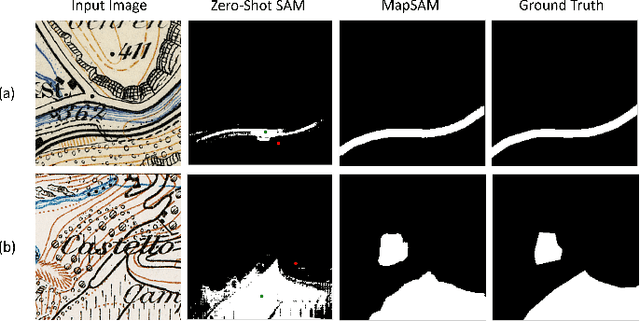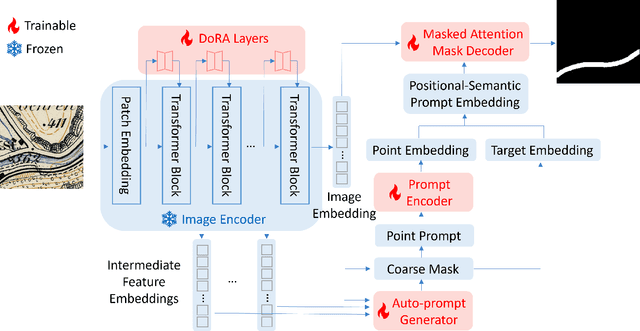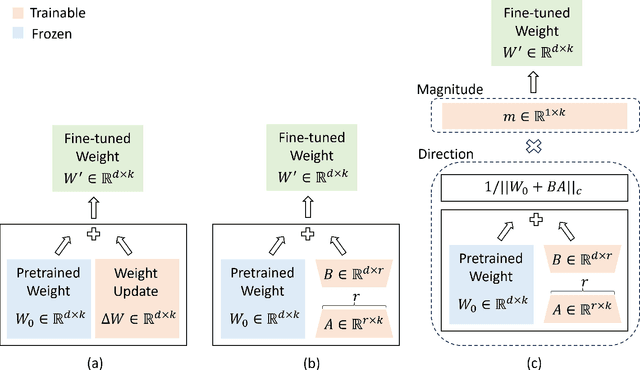Wenxuan Song
VLA-Adapter: An Effective Paradigm for Tiny-Scale Vision-Language-Action Model
Sep 11, 2025Abstract:Vision-Language-Action (VLA) models typically bridge the gap between perceptual and action spaces by pre-training a large-scale Vision-Language Model (VLM) on robotic data. While this approach greatly enhances performance, it also incurs significant training costs. In this paper, we investigate how to effectively bridge vision-language (VL) representations to action (A). We introduce VLA-Adapter, a novel paradigm designed to reduce the reliance of VLA models on large-scale VLMs and extensive pre-training. To this end, we first systematically analyze the effectiveness of various VL conditions and present key findings on which conditions are essential for bridging perception and action spaces. Based on these insights, we propose a lightweight Policy module with Bridge Attention, which autonomously injects the optimal condition into the action space. In this way, our method achieves high performance using only a 0.5B-parameter backbone, without any robotic data pre-training. Extensive experiments on both simulated and real-world robotic benchmarks demonstrate that VLA-Adapter not only achieves state-of-the-art level performance, but also offers the fast inference speed reported to date. Furthermore, thanks to the proposed advanced bridging paradigm, VLA-Adapter enables the training of a powerful VLA model in just 8 hours on a single consumer-grade GPU, greatly lowering the barrier to deploying the VLA model. Project page: https://vla-adapter.github.io/.
FlowVLA: Thinking in Motion with a Visual Chain of Thought
Aug 25, 2025Abstract:Many Vision-Language-Action (VLA) models rely on an internal world model trained via next-frame prediction. This approach, however, struggles with physical reasoning as it entangles static appearance with dynamic motion, often resulting in implausible visual forecasts and inefficient policy learning. To address these limitations, we introduce the Visual Chain of Thought (Visual CoT): a pre-training framework that encourages a model to reason about how a scene evolves before predicting what it will look like. We instantiate this principle in FlowVLA, which predicts a future frame ($v_{t+1}$) only after generating an intermediate optical flow representation ($f_t$) that encodes motion dynamics. This ``$v_t \rightarrow f_t \rightarrow v_{t+1}$'' reasoning process is implemented within a single autoregressive Transformer, guiding the model to learn disentangled dynamics. As a result, FlowVLA produces coherent visual predictions and facilitates more efficient policy learning. Experiments on challenging robotics manipulation benchmarks demonstrate state-of-the-art performance with substantially improved sample efficiency, pointing toward a more principled foundation for world modeling. Project page: https://irpn-lab.github.io/FlowVLA/
ReconVLA: Reconstructive Vision-Language-Action Model as Effective Robot Perceiver
Aug 14, 2025Abstract:Recent advances in Vision-Language-Action (VLA) models have enabled robotic agents to integrate multimodal understanding with action execution. However, our empirical analysis reveals that current VLAs struggle to allocate visual attention to target regions. Instead, visual attention is always dispersed. To guide the visual attention grounding on the correct target, we propose ReconVLA, a reconstructive VLA model with an implicit grounding paradigm. Conditioned on the model's visual outputs, a diffusion transformer aims to reconstruct the gaze region of the image, which corresponds to the target manipulated objects. This process prompts the VLA model to learn fine-grained representations and accurately allocate visual attention, thus effectively leveraging task-specific visual information and conducting precise manipulation. Moreover, we curate a large-scale pretraining dataset comprising over 100k trajectories and 2 million data samples from open-source robotic datasets, further boosting the model's generalization in visual reconstruction. Extensive experiments in simulation and the real world demonstrate the superiority of our implicit grounding method, showcasing its capabilities of precise manipulation and generalization. Our project page is https://zionchow.github.io/ReconVLA/.
CEED-VLA: Consistency Vision-Language-Action Model with Early-Exit Decoding
Jun 16, 2025Abstract:In recent years, Vision-Language-Action (VLA) models have become a vital research direction in robotics due to their impressive multimodal understanding and generalization capabilities. Despite the progress, their practical deployment is severely constrained by inference speed bottlenecks, particularly in high-frequency and dexterous manipulation tasks. While recent studies have explored Jacobi decoding as a more efficient alternative to traditional autoregressive decoding, its practical benefits are marginal due to the lengthy iterations. To address it, we introduce consistency distillation training to predict multiple correct action tokens in each iteration, thereby achieving acceleration. Besides, we design mixed-label supervision to mitigate the error accumulation during distillation. Although distillation brings acceptable speedup, we identify that certain inefficient iterations remain a critical bottleneck. To tackle this, we propose an early-exit decoding strategy that moderately relaxes convergence conditions, which further improves average inference efficiency. Experimental results show that the proposed method achieves more than 4 times inference acceleration across different baselines while maintaining high task success rates in both simulated and real-world robot tasks. These experiments validate that our approach provides an efficient and general paradigm for accelerating multimodal decision-making in robotics. Our project page is available at https://irpn-eai.github.io/CEED-VLA/.
RationalVLA: A Rational Vision-Language-Action Model with Dual System
Jun 12, 2025Abstract:A fundamental requirement for real-world robotic deployment is the ability to understand and respond to natural language instructions. Existing language-conditioned manipulation tasks typically assume that instructions are perfectly aligned with the environment. This assumption limits robustness and generalization in realistic scenarios where instructions may be ambiguous, irrelevant, or infeasible. To address this problem, we introduce RAtional MAnipulation (RAMA), a new benchmark that challenges models with both unseen executable instructions and defective ones that should be rejected. In RAMA, we construct a dataset with over 14,000 samples, including diverse defective instructions spanning six dimensions: visual, physical, semantic, motion, safety, and out-of-context. We further propose the Rational Vision-Language-Action model (RationalVLA). It is a dual system for robotic arms that integrates the high-level vision-language model with the low-level manipulation policy by introducing learnable latent space embeddings. This design enables RationalVLA to reason over instructions, reject infeasible commands, and execute manipulation effectively. Experiments demonstrate that RationalVLA outperforms state-of-the-art baselines on RAMA by a 14.5% higher success rate and 0.94 average task length, while maintaining competitive performance on standard manipulation tasks. Real-world trials further validate its effectiveness and robustness in practical applications. Our project page is https://irpn-eai.github.io/rationalvla.
OpenHelix: A Short Survey, Empirical Analysis, and Open-Source Dual-System VLA Model for Robotic Manipulation
May 06, 2025Abstract:Dual-system VLA (Vision-Language-Action) architectures have become a hot topic in embodied intelligence research, but there is a lack of sufficient open-source work for further performance analysis and optimization. To address this problem, this paper will summarize and compare the structural designs of existing dual-system architectures, and conduct systematic empirical evaluations on the core design elements of existing dual-system architectures. Ultimately, it will provide a low-cost open-source model for further exploration. Of course, this project will continue to update with more experimental conclusions and open-source models with improved performance for everyone to choose from. Project page: https://openhelix-robot.github.io/.
MoRE: Unlocking Scalability in Reinforcement Learning for Quadruped Vision-Language-Action Models
Mar 11, 2025Abstract:Developing versatile quadruped robots that can smoothly perform various actions and tasks in real-world environments remains a significant challenge. This paper introduces a novel vision-language-action (VLA) model, mixture of robotic experts (MoRE), for quadruped robots that aim to introduce reinforcement learning (RL) for fine-tuning large-scale VLA models with a large amount of mixed-quality data. MoRE integrates multiple low-rank adaptation modules as distinct experts within a dense multi-modal large language model (MLLM), forming a sparse-activated mixture-of-experts model. This design enables the model to effectively adapt to a wide array of downstream tasks. Moreover, we employ a reinforcement learning-based training objective to train our model as a Q-function after deeply exploring the structural properties of our tasks. Effective learning from automatically collected mixed-quality data enhances data efficiency and model performance. Extensive experiments demonstrate that MoRE outperforms all baselines across six different skills and exhibits superior generalization capabilities in out-of-distribution scenarios. We further validate our method in real-world scenarios, confirming the practicality of our approach and laying a solid foundation for future research on multi-task learning in quadruped robots.
Accelerating Vision-Language-Action Model Integrated with Action Chunking via Parallel Decoding
Mar 04, 2025Abstract:Vision-Language-Action (VLA) models demonstrate remarkable potential for generalizable robotic manipulation. The performance of VLA models can be improved by integrating with action chunking, a critical technique for effective control. However, action chunking linearly scales up action dimensions in VLA models with increased chunking sizes. This reduces the inference efficiency. To tackle this problem, we propose PD-VLA, the first parallel decoding framework for VLA models integrated with action chunking. Our framework reformulates autoregressive decoding as a nonlinear system solved by parallel fixed-point iterations. This approach preserves model performance with mathematical guarantees while significantly improving decoding speed. In addition, it enables training-free acceleration without architectural changes, as well as seamless synergy with existing acceleration techniques. Extensive simulations validate that our PD-VLA maintains competitive success rates while achieving 2.52 times execution frequency on manipulators (with 7 degrees of freedom) compared with the fundamental VLA model. Furthermore, we experimentally identify the most effective settings for acceleration. Finally, real-world experiments validate its high applicability across different tasks.
MapSAM: Adapting Segment Anything Model for Automated Feature Detection in Historical Maps
Nov 11, 2024



Abstract:Automated feature detection in historical maps can significantly accelerate the reconstruction of the geospatial past. However, this process is often constrained by the time-consuming task of manually digitizing sufficient high-quality training data. The emergence of visual foundation models, such as the Segment Anything Model (SAM), offers a promising solution due to their remarkable generalization capabilities and rapid adaptation to new data distributions. Despite this, directly applying SAM in a zero-shot manner to historical map segmentation poses significant challenges, including poor recognition of certain geospatial features and a reliance on input prompts, which limits its ability to be fully automated. To address these challenges, we introduce MapSAM, a parameter-efficient fine-tuning strategy that adapts SAM into a prompt-free and versatile solution for various downstream historical map segmentation tasks. Specifically, we employ Weight-Decomposed Low-Rank Adaptation (DoRA) to integrate domain-specific knowledge into the image encoder. Additionally, we develop an automatic prompt generation process, eliminating the need for manual input. We further enhance the positional prompt in SAM, transforming it into a higher-level positional-semantic prompt, and modify the cross-attention mechanism in the mask decoder with masked attention for more effective feature aggregation. The proposed MapSAM framework demonstrates promising performance across two distinct historical map segmentation tasks: one focused on linear features and the other on areal features. Experimental results show that it adapts well to various features, even when fine-tuned with extremely limited data (e.g. 10 shots).
ProFD: Prompt-Guided Feature Disentangling for Occluded Person Re-Identification
Sep 30, 2024



Abstract:To address the occlusion issues in person Re-Identification (ReID) tasks, many methods have been proposed to extract part features by introducing external spatial information. However, due to missing part appearance information caused by occlusion and noisy spatial information from external model, these purely vision-based approaches fail to correctly learn the features of human body parts from limited training data and struggle in accurately locating body parts, ultimately leading to misaligned part features. To tackle these challenges, we propose a Prompt-guided Feature Disentangling method (ProFD), which leverages the rich pre-trained knowledge in the textual modality facilitate model to generate well-aligned part features. ProFD first designs part-specific prompts and utilizes noisy segmentation mask to preliminarily align visual and textual embedding, enabling the textual prompts to have spatial awareness. Furthermore, to alleviate the noise from external masks, ProFD adopts a hybrid-attention decoder, ensuring spatial and semantic consistency during the decoding process to minimize noise impact. Additionally, to avoid catastrophic forgetting, we employ a self-distillation strategy, retaining pre-trained knowledge of CLIP to mitigate over-fitting. Evaluation results on the Market1501, DukeMTMC-ReID, Occluded-Duke, Occluded-ReID, and P-DukeMTMC datasets demonstrate that ProFD achieves state-of-the-art results. Our project is available at: https://github.com/Cuixxx/ProFD.
 Add to Chrome
Add to Chrome Add to Firefox
Add to Firefox Add to Edge
Add to Edge